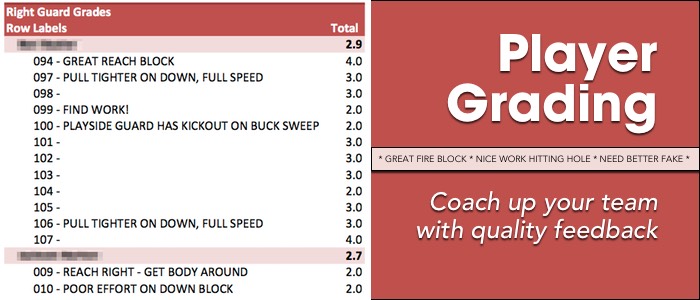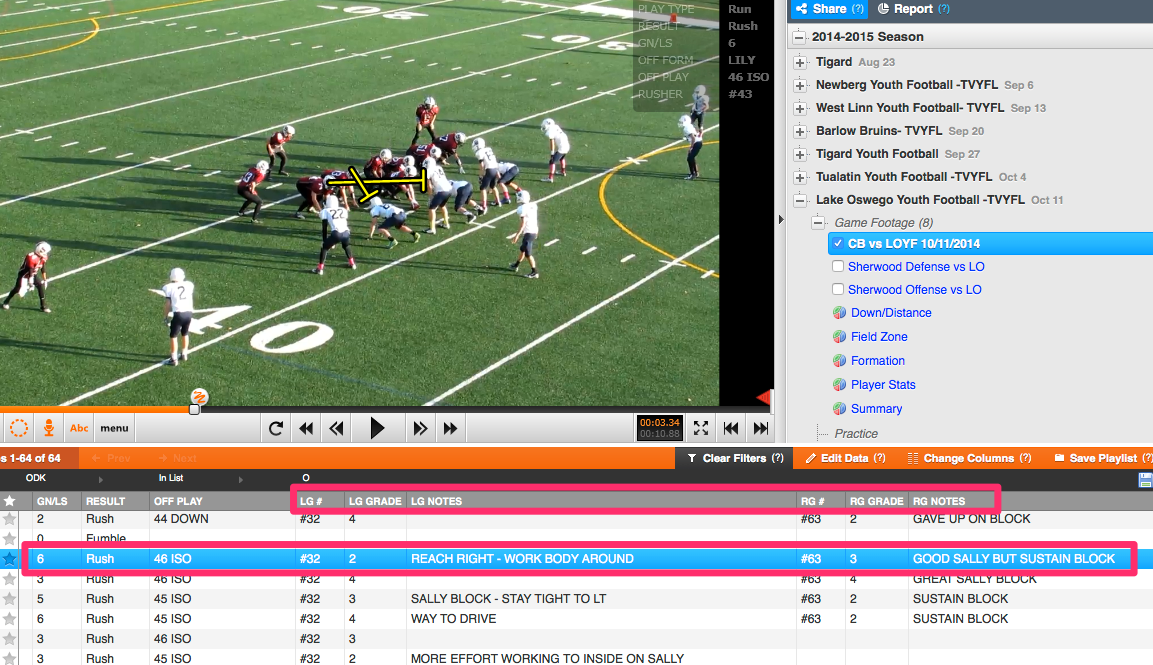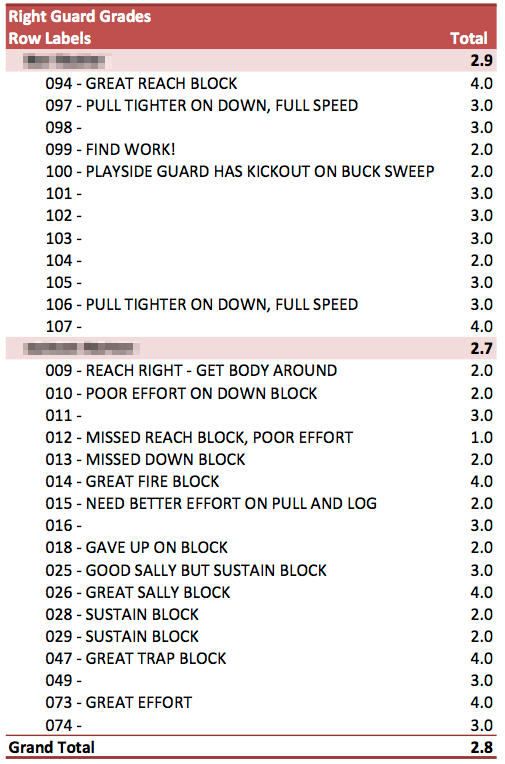Player Grading: Coach Up Your Team

I’ve been a business leader and a parent for over 20 years, and one common challenge I confront with myself as well as with others I’m coaching or leading is this: how can you consistently give effective, constructive feedback? Even positive feedback is difficult, for example how do the words “good job” help reinforce good behavior or execution?
In this post I’ll talk about a specific improvement we made this year in how we give feedback to players: grading game execution through film review. But first, let’s talk about the broader subject of feedback. Bear with me – this will all tie back to giving feedback to your players.

When I teach or mentor new managers in the work environment, I teach the following steps (thanks Manager Tools):
- Ask “may I give you some feedback?” Or, “Can we talk about that?” What if they say NO? Walk away, move on.
- Describe the behavior. “When you show up 10 minutes late to the standup meeting…”. “When you spend time over the weekend to take a second look at that client issue…”
- Describe the impact. Impacts don’t have to be big or important. “it disrupts the team and results in extra questions and clarifications”. “Here’s what happened: our client sent me an email thanking the company for going the extra mile to really understand the root cause.”
- Discuss future behavior. This can be just “thank you” for affirming feedback. For adjusting feedback, “What can we do better?” or “Is there a better way for you to approach this next time?”
There are aspects of coaching football that make giving feedback both easier and harder than giving feedback in the work environment. During practices and games, you don’t have time nor is it reasonable by any stretch to approach a player and say “hey, can I give you some feedback?” Players expect to get feedback from coaches, but all too often it comes in the form of non-specific, unhelpful yelling. “Block somebody!” is completely worthless, while “great play!” might make a player feel better and encouraged but provides nothing specific to help guide future execution. I think this is the hardest part about football coaching feedback: real-time, quick, specific, supportive feedback during drills, team practice, and games. That’s a subject for a future post.
Football coaches have an advantage, however, over most business environments: most of us have access to film and, given the right amount of time investment, you have a gold mine of information to use. Sadly, I’m afraid that most youth coaches don’t put in the time to take advantage of this treasure trove. For many years I’ve used selective video cutups with annotation for players, and I even built my own workflow for doing this before using Hudl. Hudl made things so much easier over the past 4 years, allowing me to provide more feedback more consistently in less time.
Last season I wanted to introduce another feedback mechanism: player grading. I did a lot of research on approach and workflow for this, and found great resources here:
- Football Grading Systems Resources
- Grade your youth football team’s performance
- Streamline The Player Grading Process
We did grading two different times during the season. While it would be ideal to do this after each game, I think it was too much to ask for just three volunteer coaches who also must worry about opponent scouting, practice prep, etc. We did find that the process went faster with practice. Let me walk you through exactly how we approached grading:

- I put in the time to setup Hudl to allow us to effectively grade every position. This is tedious and I’d love to see Hudl automate this or incorporate standard loadable sets. For each position, I added a column that included the roster #, the grade for that play, and an optional notes column. The good news: once you set this up, you have it available for all of your breakdown.
- I then saved these columns into “Column Sets” for groups of players. For example, I would grade the left and right guards on each play, then the left and right tackle, then the center and TE. Hence, there were three different Column Sets that I used (“Guard Grades”, “Tackle Grades”, “C and TE Grades”).
- We agreed on a rubric for grading players, using a 1–4 scale. Our rubric was as follows:
- 1 – the player showed poor effort and did not properly execute
- 2 – the player either showed poor effort or did not properly execute their assignment
- 3 – the player either showed great effort or executed properly
- 4 – the player both showed great effort and executed properly
- We sat down as a staff and did a trial grading walkthrough to calibrate us all. We did this with running backs first, and it was an eye opening experience. If you’ve coached for a while, you probably know where I’m going: we saw effort and execution for players that surprised us (both positively and negatively). Why? Because we spent so much time looking at players not carrying the ball.
- We then independently graded our position players for the entire game. It was important for us to score “garbage time” (our first game we scored was a loss where the other team went to 2nd and 3rd string for most of the fourth quarter) because it allowed us to get grades and feedback for many of our backups.
- After our grading was complete, I then exported this breakdown data to Excel to provide summary scorecards for players. I'm a fairly advanced Excel user and used pivot tables to create the summaries, but even a beginner should be able to do player-specific averages. I included the clip number and comment on the handout so that the players could then go back home and review the specific clips and observe their performance.

We debated how we would share the data with the players and opted for full transparency. We broke into position groups and handed out the scoresheets to players with summaries by position. So my right guards saw the scoring for all of the right guards. We explained that we weren’t judging them as players, just giving feedback on the performance we observed in a game on a specific play. We were also able to reset expectations about execution and effort (especially effort).
The players responded extremely well to this. They took the feedback like the young men that they were, and we saw renewed focus and effort. We saw better fakes and blocking by our wingbacks. We saw better execution on the backside by our offensive line. We heard anecdotal feedback from a player’s dad that his son commented about how much he appreciated the coaches talking straight to them, sharing data, “and treating us like men.”
In summary, even if you aren’t able to do this every game, commit to a grading and feedback model like this. Especially early in the season when you are potentially still settling on starting players, putting players in the right position, and generally completing your evaluation process. It won’t just help the players: it will help the coaches be more objective (avoiding the halo effect) and more prepared to coach their players.